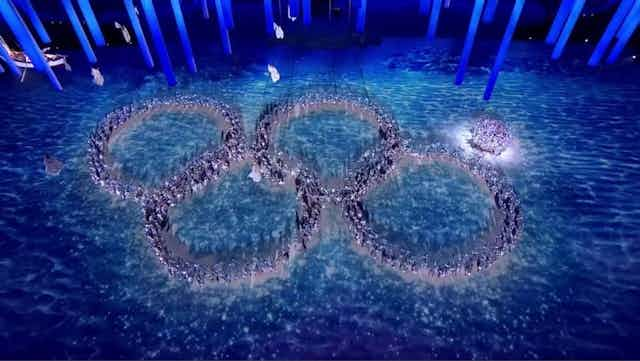Tasked with winding down the over-exuberance of the build-up, Olympics closing ceremonies always have an anti-climactic tone. Terrorists from the Caucasus failed to disrupt the Sochi event, and the most visibly violent outbreak appears to have been the Cossack attack on Pussy Riot.
In Sochi to shoot their latest video, Putin Will Teach You to Love the Motherland, the women were set upon, sprayed with pepper and horsewhipped by a group of Cossacks, the self-organised militias, providing security around the Olympic site.
Watching one version of the attack, the footage – like the group itself – seems highly ambiguous, in the way that its recording imposes a duration that could almost be staged for the video (where some of it is used).
It is easy to recall Chris Marker’s analysis of a short extract in the 1957 documentary Letter from Siberia that manages to describe the same footage in three different ways, depending on your ideological point of view.
The European view
The Konstantin Ernst opening ceremony of the Sochi Winter Olympics featured, among other historical figures, all the “queer” Russians (Gogol, Tchaikovsky, Nijinsky, Diaghilev, Eisenstein), in a nod to Russia’s much criticised anti-gay policy.
By contrast, the closing ceremony, directed by Ernst’s friend, Daniele Finzi Pasca, presented a “European view” of Russia as a fantasy children’s playground, devoid of any of the unpleasantness of history. This is seemingly in keeping with Putin’s pronouncements that gay people would not be subjected to harassment at the Olympics as long as they stayed away from children. And to make this truly effective, everyone had to be infantilised – to see reality through the eyes of children.

Three children – the opening ceremony’s Lyubov (“love” in Russian), Yuri (after Gagarin) and Valentina (after Tereshkova, the first woman cosmonaut) – wander through an LED forest, a wonderland. A tribute ostensibly to Russian avant-garde masters Malevich, Kandinsky and Chagall mostly focuses on the upside-down houses of (“shtetl modernist”) Chagall’s 1911 painting, “I and the Village”, with a flying boat and wire-working “messengers of light” floating overhead.
Perhaps Malevich’s degree zero painting is registered abstractly in the assumed suprematism of some vague aspiration for “new horizons” and Kandinsky exists somehow in the colour shifts of the LEDs. (I’m trying hard here to enter into the spirit of it.)
A Music chapter features Rachmaninov’s 1901 Piano Concerto No 2, and 62 fake pianos circling soloist Denis Matsuev, followed by a Theatre chapter “dance-off” between arch-rivals, the Moscow-based Bolshoi Ballet and the St Petersburg-based Mariinsky Company, with Ballet Russes riffs.
Like de Custine (“the European”) who refuses to enter the 20th century in Sokurov’s 2002 film Russian Ark, Finzi Pasca’s 19th century classical culture fantasy notably doesn’t dwell upon post-revolutionary culture – except in image flashes in the Literature section, where writers labour over desks that rarely contain typewriters.

Chekhov appears to be the only modernist in this regard, and if you were especially observant you will have seen Pushkin, Tolstoy, Dostoevsky, Gogol, Turgenev, and then into the 20th century, Chekhov, Mayakovsky, Akhmatova, Tsvetaeva, Brodsky, Bulgakov and Solzhenitsyn, before they disappear underground.
The circus
It seems completely fitting that the Russian culture section concludes with the circus. A tent is hastily erected on stage – and in fact the whole games have been an enormous circus that has been erected in haste but now remains a lasting monument to Putin, and the revival of tourism on the Black Sea, in the very city where Stalin had his dacha.

The threat from the immediately neighbouring Caucasus recedes at exactly the moment that, just north-west across the water, the Ukraine appears to have shifted towards the West in the overthrow of President Viktor Yanukovich on the last day of the Sochi Olympics.
All that remains is to hand the flag on to South Korea, where the 23rd Winter Games will be held in 2018. A sage takes the stage, performing on the 12-stringed gayageum a supplication to the gods for a new beginning.
Three singers – the classical singer Sumi Jo, the jazz singer Nah Youn-sun and the ageing K-Pop star Lee Seung-chul – perform versions of the folk song “Arirang”, an alternative “national anthem”, popular since the Korean War, when it was adopted as the official marching song of the US 7th Infantry Division.

The bottom line
Was it all worth it?
The Russian Winter Olympics reportedly cost A$56.8 billion to stage – which is more than the 2013-14 Australian current budget deficit.
Russia’s booming resources industries (oil and gas) have given them quarter after quarter of huge surpluses since 1998 (a bumper A$44 billion surplus in Q1, 2012 and A$28 billion in Q1, 2013; its Q3, 2013 surplus – a mere A$701 million – was, as a Bloomberg report notes, its smallest surplus since 1998!
I’m still trying to figure out why exactly it is that after the largest resources boom in Australian history, we still have deficits, rather than surpluses. Is it really government profligacy, private kleptocracy or a mix of both? Or is just a matter of accounting? Economics is a far greater mystery than Russian culture, a far greater children’s fantasy than Finzi Pasca’s closing ceremony imagines Russia to be.
To bring all this home, Australia didn’t score gold at Sochi. Could this be because all our gold is gone?

